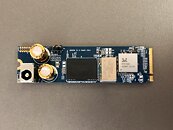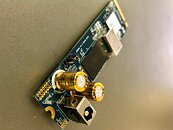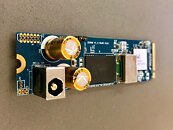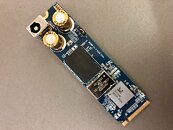- Joined
- Oct 9, 2007
- Messages
- 47,240 (7.55/day)
- Location
- Hyderabad, India
| System Name | RBMK-1000 |
|---|---|
| Processor | AMD Ryzen 7 5700G |
| Motherboard | ASUS ROG Strix B450-E Gaming |
| Cooling | DeepCool Gammax L240 V2 |
| Memory | 2x 8GB G.Skill Sniper X |
| Video Card(s) | Palit GeForce RTX 2080 SUPER GameRock |
| Storage | Western Digital Black NVMe 512GB |
| Display(s) | BenQ 1440p 60 Hz 27-inch |
| Case | Corsair Carbide 100R |
| Audio Device(s) | ASUS SupremeFX S1220A |
| Power Supply | Cooler Master MWE Gold 650W |
| Mouse | ASUS ROG Strix Impact |
| Keyboard | Gamdias Hermes E2 |
| Software | Windows 11 Pro |
A company dealing with niche audiophile-grade electronics on Audiophile Style, a popular site and marketplace for the community, conjured up an SSD that it feels offers the best possible audio. Put simply, this is an M.2-2280 NVMe SSD with a fully-independent power delivery mechanism (one that's isolated from the motherboard's power delivery), and an over-the-top discrete clock-source for its controller. The drive has its own 5 V 2-pin DC input and switching hardware onboard, including [get this] a pair of Audionote Kaisei audio-grade electrolytic capacitors in place of what should have been simple solid-state SMD capacitors that are hard to even notice on any other drive. It doesn't end there.
Most NVMe SSDs have a tiny 2 mm x 2 mm SMD oscillator that's used by the controller for clock-generation. This drive features a Crystek CCHD-957 high-grade Femto oscillator. These oscillators are found in some very high-grade production or scientific equipment, such as data-loggers. For the drive itself, you get a Realtek DRAM-less controller, and a single 1 TB TLC NAND flash chip that's forced to operate in SLC mode (333 GB). On a scale of absurdity, this drive is right up there with $10,000 HDMI cables. Digital audio is stored in ones and zeroes, and nothing is accomplished through an isolated power delivery or clock generation on the storage media. It's nice of the designers to include jumpers that let you switch between the discrete power source and motherboard power; so listeners can see the snake-oil for themselves.




View at TechPowerUp Main Site
Most NVMe SSDs have a tiny 2 mm x 2 mm SMD oscillator that's used by the controller for clock-generation. This drive features a Crystek CCHD-957 high-grade Femto oscillator. These oscillators are found in some very high-grade production or scientific equipment, such as data-loggers. For the drive itself, you get a Realtek DRAM-less controller, and a single 1 TB TLC NAND flash chip that's forced to operate in SLC mode (333 GB). On a scale of absurdity, this drive is right up there with $10,000 HDMI cables. Digital audio is stored in ones and zeroes, and nothing is accomplished through an isolated power delivery or clock generation on the storage media. It's nice of the designers to include jumpers that let you switch between the discrete power source and motherboard power; so listeners can see the snake-oil for themselves.




View at TechPowerUp Main Site







